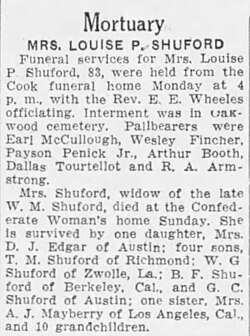
The search for Texas obituaries and the discovery of family lineage relating to those obituaries is a unique process. Texas death's were recorded starting in 1903. Starting in 1910 death certificates were arranged by surnames followed by given names, and were also numbered[1]. While home burials are allowed in Texas, local laws must be followed. Death certificates are not public record in the state of Texas. They are only released after 25 years of the person's death. the state bureau of vital statistics in Austin, Texas. The easiest way in Texas to get a death record is via online at Texas Department of State Health Services site.
Research your ancestors on MyHeritage
Finding Texas ObituariesFinding Texas Obituaries
See also: American Civil War
Finding Texas obituaries is complicated by it's history. It is one of the only states, prior to the United States becoming a united entity, that was part of several different countries. First it was part of colonial Spain, then Mexico. Finally, before becoming part of the Union it was part of the Confederacy.
Information contained in an obituaryInformation contained in an obituary
Obituaries can provide important information such as the different associations of the deceased person including social organizations they were involved in. Additionally, information such as the cause of death and/or place of death are important In obtaining an obituary. For this reason, it's important that one finds out where the person died. This can be obtained by researching the local or city register's office. It's also important to understand where that person died to find further information such as old newspapers.[2]
Additional information that could be in included in an obituary are:
- Name: The name of the deceased will be in the obituary. Sometimes this will include the full name, a middle name, maiden names, married names, and even nicknames.
- Vital Information: Vital information such as birth dates, marriage dates, and death dates could be listed in an obituary, along with the deceased age at death.
- Family Members: Obituaries historically have listed the deceased family members if they are known. They could be listed as those that have predeceased the individual and those that survive the deceased. Family members such as parents, spouses, children, grandchildren and even nieces and nephews.
- Church Affiliation: If a person was a member of a particular denomination or a specific local church, that information could be listed in the obituary. In fact, many times the funeral services could be held at the church the deceased attended. The oldest church is the San Fernando Cathedral. Named after Ferdinand III of Castille who ruled during the 13th century.

San Fernando Cathedral in San Antonio, Texas - Career Information: Many obituaries could give information about the deceased's work history, including where they worked, how long they worked there and any noted accomplishments in their career.
- Military Service Information: An individual's military service can be listed in an obituary. This information could include the branch of service, wars they were involved in, if they were retired and the years of service they have given to their country. Famous military personnel that were buried in San Fernando Cathedral include: David " Davie" Crockett. The wedding of Jim Bowie to Ursala de Veramendi also took place here.[3]
- Burial Information: Obituaries can include the date of burial and the name and location of the cemetery where the deceased is to be buried.[4]
How to find an obituaryHow to find an obituary
Generally, the date of death is the first key piece of information that could enable one to more easily find a deceased person in a newspaper. Using both State and local resources are essential; the State index and the cemetery in the local area where the person is believed to have died are good examples. The next step in finding an obituary is the date of death. Once that is determined, a search in the local library is a good next step. Here, it can be seen whether or not newspapers were in existence during that specific time period, and if it would be common for someone to look for an obituary in that newspaper. If the newspapers are not kept at the library, one can contact the local newspaper office to see if it would be possible to obtain older copies of the particular newspaper in question.
See alsoSee also
Explore more about Texas obituariesExplore more about Texas obituaries
- Texas death recordsin MyHeritage record collection.
- How to Write an Obituary at MyHeritage blog.
- Thekla Agnes Kosub (Koehler) family tree in MyHeritage record collection.
- Texas Death Certificates by county in BillionGraves.
- Ethnicity map of Texas at MyHeritage.
- Chronicling America: Historic American Newspapers in MyHeritage record collection.
- Ferdinand III of Castile family tree at MyHeritage record collection.
- James Bowie family tree in MyHeritage record collection.
- David Crockett headstone record in BillionGraves.
- Texas and the Texans Volume 1 in MyHeritage record collection.
- Newspaper and Funeral Home obituaries in MyHeritage record collection.
- Introducing OldNews.com at MyHeritage Blog.
- The "Father of Texas" Stephen Fuller Austin in Geni record collection.
- Collin McKinney obituary in MyHeritage record collection.
- Rene-Robert Cavelier de La Salle in Geni record collection.

